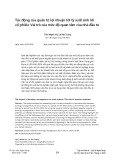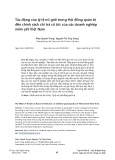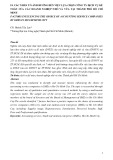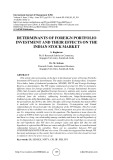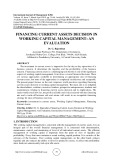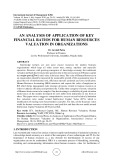
* Corresponding author
E-mail address: buingoctoan@iuh.edu.vn (T. N. Bui)
© 2020 by the authors; licensee Growing Science.
doi: 10.5267/j.uscm.2019.12.003
Uncertain Supply Chain Management 8 (2020) 285–290
Contents lists available at GrowingScience
Uncertain Supply Chain Management
home
p
a
g
e: www.Growin
g
Science.com/usc
m
How do financial leverage and supply chain finance influence firm performance? Evidence from
construction sector
Toan Ngoc Buia*
aFaculty of Finance and Banking, Industrial University of Ho Chi Minh City (IUH), Vietnam
C H R O N I C L E A B S T R A C T
Article history:
Received October 20, 2019
Received in revised format
November 25, 2019
Accepted December 24 2019
Available online
December 24 2019
This paper investigates the impact of financial leverage and supply chain finance on firm
performance of Vietnamese construction sector. Although there is a big gap in the literature
needed to be filled, little empirical evidence can be found on this interesting topic. Therefore,
the results are essential for Vietnamese firms, particularly those in construction industry. By
adopting the generalized method of moment (GMM), the results reveal the significant
influence of financial leverage and supply chain finance on the performance of construction
firms. In particular, firm performance (FP) is more influenced by financial leverage (FL) than
supply chain finance (SCF). The findings also show that supply chain finance plays a key role
in enhancing firm performance. Meanwhile, more debts and their inefficient use exert a
negative impact on firm performance, which is an unprecedented finding of this study.
.license Growin
g
Science, Canada2020 b
y
the authors; ©
Keywords:
Cash conversion cycle
Construction sector
Financial leverage
Performance
Vietnam
1. Introduction
In the context of the international integration, Vietnamese construction sector is facing a number of big
challenges. Particularly, capital access is one of the matters which attracts much attention from
construction firms. Especially, Vietnam economy has just overcome a recession caused by the global
financial crisis, so it becomes more difficult for construction companies in accessing to capital. This
source helps these firms not only maintain their operations but also raise their competitive ability
against other multinational firms with high financial capacity expanding to Vietnam’s market. Together
with using financial leverage through traditional channels, specifically credit organizations,
construction firms show more concern on short-term credit through supply chain finance. It is because
short-term credit allows enterprises optimise their working capital at a low cost (Wuttke et al., 2013),
thereby enhancing firm performance (Lekkakos & Serrano, 2016). Although the role of financial
leverage and supply chain finance in improving firm performance cannot be denied, their concurrent
impact on corporate performance has not been empirically examined in many studies. Hence, this paper
aims to give first empirical evidence on this influence. Especially, the data are obtained from
Vietnamese companies in construction industry which is growing impressively but still facing many
difficulties in the capital access. Therefore, this paper is expected to reveal more interesting findings.

286
2. Literature review
2.1. Financial leverage and firm performance
Financial leverage refers to how firms use their debt. In their use, firms experience benefits of tax
shields which lower the overall amount of income tax which they need to pay for the state by a reduction
in taxable income, thereby enhancing their performance. In other words, the use of financial leverage
possibly exerts positive influence on the corporate performance. This is consistent with what have been
reported by Burja (2011), Seelanatha (2011), Nirajini and Priya (2013), Sivathaasan et al. (2013),
Ghayas and Akhter (2018). However, the use of financial leverage can also bring firms more financial
risks. Indeed, more debts and their inefficient use put firms in bankruptcy risk, which may negatively
affect the corporate performance. The negative influence of financial leverage on firm performance has
been also found by Azhagaiah and Gavoury (2011), Malik (2011), Akinlo and Asaolu (2012), González
(2013), Hamid et al. (2015), Vithessonthi and Tongurai (2015), Daud et al. (2016), Ameen and
Shahzadi (2017).
2.2. Supply chain finance and firm performance
Supply chain finance is frequently measured through cash conversion cycle (Zhang et al., 2019).
Accordingly, cash conversion cycle is defined as the period starting from the cash outlay to cash
recovery (Bui, 2020). Reducing cash conversion cycle makes the financial link among participants
stronger (Wuttke et al., 2013), which means supply chain finance performs better. More than that, this
allows its participants take use of short-term credit at a low cost, thereby boosting firm performance
(Bui, 2020). Therefore, supply chain finance greatly contributes in optimizing corporate financial flows
(Pfohl & Gomm, 2009), stabilising the holistic supply chain (Klapper, 2006), and most notably,
enhancing firm performance (Lekkakos & Serrano, 2016). In other words, supply chain finance is
positively correlated with firm performance meanwhile cash conversion cycle has a negative impact on
how firms perform. This negative influence has been revealed in studies of Zhang et al. (2019) and Bui
(2020).
3. Data and Methodology
3.1. Data Collection
Data are collected from financial reports of 30 construction companies listed on Vietnam stock market.
The data are obtained in the period from 2015 to 2018. Further, data on economic growth are collected
from World Bank source.
3.2. Methodology
The study analyses the impact of financial leverage and supply chain finance on performance of
construction firms in Vietnam. Therefore, the model is estimated by adopting the Pooled Regression
model (Pooled OLS), Fixed effects model (FEM) and Random effects model (REM). Next, the
Generalized Method of Moment (GMM) which allows to control potential endogeneity and detect
violations of null hypotheses is employed in the estimation to assure the reliability of the results
(Doytch & Uctum, 2011). Following earlier researchers, the author measures firm performance (FP)
by return on assets ratio (ROA). Financial leverage (FL) is measured by total debt to total equity while
supply chain finance (SCF) is performed by cash conversion cycle (CCC). In addition, firm size
(logarithm of total assets) and economic growth are included as control variables in the model. The
former representing for firm characteristics has been adopted in the analyses of Malik (2011), Akinlo
and Asaolu (2012), Sivathaasan et al. (2013), Hamid et al. (2015), Vithessonthi and Tongurai (2015),
Daud et al. (2016) while the latter as an indicator of the macroeconomy was also been found in the
research of Vithessonthi and Tongurai (2015). Therefore, the research model is estimated in the
following equation:

T. N. Bui /Uncertain Supply Chain Management
8 (2020)
287
FP
it
= β
0
+ β
1
FL
it
+ β
2
SCF
it
+ β
3
SIZE
it
+ β
4
EG
t
+ ε
it
(1)
Source: Research model proposed by the author.
Fig. 1. The impact of financial leverage and supply chain finance on firm performance
where:
Dependent variable: Firm performance (FP).
Independent variables: Financial leverage (FL), supply chain finance (SCF).
Control variables: Firm size (SIZE), economic growth (EG).
The term ε is the model regression error term.
Table 1
Summary of variables
Variable name Code Measurement
De
p
endent variable
Firm performance FP Net income / Total assets
Inde
p
endent variables
Financial leverage FL Total debt / Total equity
Supply chain finance SCF Logarithm of cash conversion cycle
Cash conversion cycle (CCC) = Days receivable + Days inventories - Days
payable = (trade receivable / sales) * 365 + (total inventories / cost of goods
sold
)
* 365 -
(
trades
p
a
y
able / cost of
g
oods sold
)
* 365
Control variables
Firm size SIZE Lo
g
arithm of total assets
Economic growth EG Annual growth of gross domestic product
Source: Research model proposed by the author.
4. Empirical Results
The correlation among variables are shown in Table 2 as follows,
Table 2
Variable correlations
FP
FL
SCF
SIZE
EG
FP 1.0000
FL -0.2265 1.0000
SCF -0.2265 -0.0761 1.0000
SIZE 0.1754 0.0571 -0.1794 1.0000
EG 0.3858 0.0155 -0.1709 0.1225 1.0000
Source: Author's computed.
Table 2 shows that the independent variables, particularly financial leverage (FL) and supply chain
finance (SCF) are negatively associated with firm performance (FP). Meanwhile, control variables,
specifically firm size (SIZE) and economic growth (EG) are positively correlated to firm performance
(FP). Next, the Pooled Regression model (Pooled OLS), Fixed effects model (FEM) and Random
effects model (REM) are adopted to estimate the model.
Financial leverage
(FL)
Supply chain finance
(SCF)
Firm performance
(FP)
SIZE, EG

288
Table 3
Regression results
FP Pooled OLS FEM REM
Constant -29.2821*** -58.4203*** -34.7289***
FL -0.0613*** -0.0449 -0.0577**
SCF -0.0003** -0.0001 -0.0003
SIZE 0.5164 1.5909 0.7102
EG 3.8750*** 3.8004 3.8812***
R
2 22.94% 29.03% 28.21%
Significance level F(4, 145) = 10.79
Prob > F = 0.0000***
F(4, 116) = 11.86
Prob > F = 0.0000***
Wald chi2(4) = 50.46
Prob > chi2 = 0.0000***
F test F(29, 116) = 2.84
Prob > F = 0.0000***
Hausman test chi2(4) = 1.94
Prob>chi2 = 0.7459
Note: *, ** and *** indicate significance at the 10%, 5% and 1% level, respectively.
Source: Author's computed.
It can be seen from Table 3 that F-test is significant at the 1% level (Prob > F = 0.0000). Meanwhile,
Hausman test shows no statistical significance (Prob>chi2 = 0.7459). It can thus be concluded that the
Random effects model (REM) is superior to the other, so it is chosen for testing the model.
Table 4
Results of testing multicollinearity
Variable FL SCF SIZE EG Mean VIF
VIF 1.01 1.06 1.04 1.04 1.04
Source: Author's computed.
Table 4 reveals that there are no serious issues of multicollinearity (Mean VIF < 10).
Table 5
Results of testing heteroscedasticity and autocorrelation
Heteroscedasticity test Autocorrelation test
chibar2(01) = 19.60
Prob > chi2 = 0.0000***
F(1, 29) = 4.530
Prob > F = 0.0419**
Note: ** and *** indicate significance at the 5% and 1% level, respectively.
Source: Author's computed.
Table 5 shows that heteroscedasticity and autocorrelation really exist at the 1% (Prob > chi2 = 0.0000)
and 5% (Prob > F = 0.0419) level of significance, respectively. Thus, the author chooses the generalized
method of moment (GMM) for the analysis in order to avoid heteroscedasticity and autocorrelation
issues. Also, GMM can address potential endogeneity.
Table 6
GMM estimation results
FP Coef. P>|z|
Constant -9.3697 0.174
FL -0.0791 0.000***
SCF -0.0002 0.045**
SIZE 0.3309 0.160
EG 1.2432 0.041**
Si
g
nificance level Wald chi2
(
3
)
= 33.89 Prob > chi2 = 0.000***
Arellano-Bond test for AR
(
2
)
in first differences z = 0.34 Pr > z = 0.732
Sar
g
an test Chi-S
q
uare
(
5
)
= 4.30 Prob > chi2 = 0.506
Note: ** and *** indicate significance at the 5% and 1% level, respectively.
Source: Author's computed.
Table 6 shows that results of GMM estimator is appropriate and valid at the 1% level of significance
(Prob > chi2 = 0.000). Also, Sargan test shows that instruments adopted are suitable. Accordingly,

T. N. Bui /Uncertain Supply Chain Management 8 (2020)
289
financial leverage (FL) exerts a negative (-0.0791) impact on firm performance (FP) at the 1% level of
significance while supply chain finance (SCF) negatively (-0.0002) affects firm performance (FP) at
the 5% significance level. Therefore, firm performance (FP) is more influenced by financial leverage
(FL) than supply chain finance (SCF). Furthermore, the result reveals the positive causality between
economic growth (EG) and firm performance (FP) at the 5% level of significance.
Hence, the results of the model take the following equation:
FPit = -0.0791 FLit - 0.0002 SCFit + 1.2432 EGt + εit (2)
The impact of financial leverage on firm performance: The findings show that the influence of
financial leverage (FL) on firm performance (FP) is negative (-0.0791) and significant at the 1% level.
Accordingly, the inefficient use of debt causes a considerable decrease in firm performance. This is
suitable for the reality in Vietnam. Recently, Vietnam real estate industry has experienced many
difficulties due to the negative impact of the international and national economy, causing lots of
obstacles to construction sector, particularly making the capital use of construction firms inefficient.
Also, these firms have to face more financial risks, which significantly affects their performance. This
is in line with the findings of Azhagaiah and Gavoury (2011), Malik (2011), Akinlo and Asaolu (2012),
González (2013), Hamid et al. (2015), Vithessonthi and Tongurai (2015), Daud et al. (2016), Ameen
and Shahzadi (2017). Nevertheless, this is the first empirical evidence on the correlation between
financial leverage and firm performance in construction sector, which is an interesting novelty of this
study.
The impact of supply chain finance on firm performance: Supply chain finance (SCF) is negatively
(- 0.0002) correlated to firm performance at the 5% significance level. This finding corroborates what
has been found by Zhang et al. (2019) and Bui (2020). Specifically, when cash conversion cycle is
shortened (supply chain finance performs well), working capital and funds of its participants will
increase. They are considerable capital sources with low cost supplying for the following operation
cycle, so firm performance will be improved. In fact, Vietnam is a developing country whose ability
and link among construction companies in the supply chain are limited. That is why the study along
with its findings on the statistically significant causality between supply chain finance and firm
performance is essential for Vietnam as well as other developing countries.
5. Conclusions
The results show that financial leverage and supply chain finance significantly influence how
Vietnamese construction firms perform. Particularly, firm performance (FP) is far more influenced by
financial leverage (FL) than supply chain finance (SCF). More than that, supply chain finance plays a
major role in enhancing firm performance. However, more debts and their ineffective use are negatively
linked to firm performance. The findings are first empirical evidence on the influence of financial
leverage and supply chain finance on firm performance in construction sector. Therefore, they are
essential for the management in construction industry to better supply chain finance and utilise financial
leverage efficiently for the performance improvement. In specific: (1) It is vital for the firms to make
plans to use debt efficiently, combined with the prediction of customers’ demands in order to set
suitable loan plans; (2) It is necessary for the firms to participate in and improve supply chain finance
to make use of its benefits. The paper succeeds in giving first empirical evidence on the influence of
financial leverage and supply chain finance on the performance of Vietnamese construction firms.
However, as a limitation of this study, the authors does not consider some control variables which may
influence firm performance such as inflation, liquidity and firm management ability. This may be an
interesting proposal for future research.
References
Akinlo, O., & Asaolu, T. (2012). Profitability and Leverage: Evidence from Nigerian firms. Global
Journal of Business Research, 6(1), 17-25.


